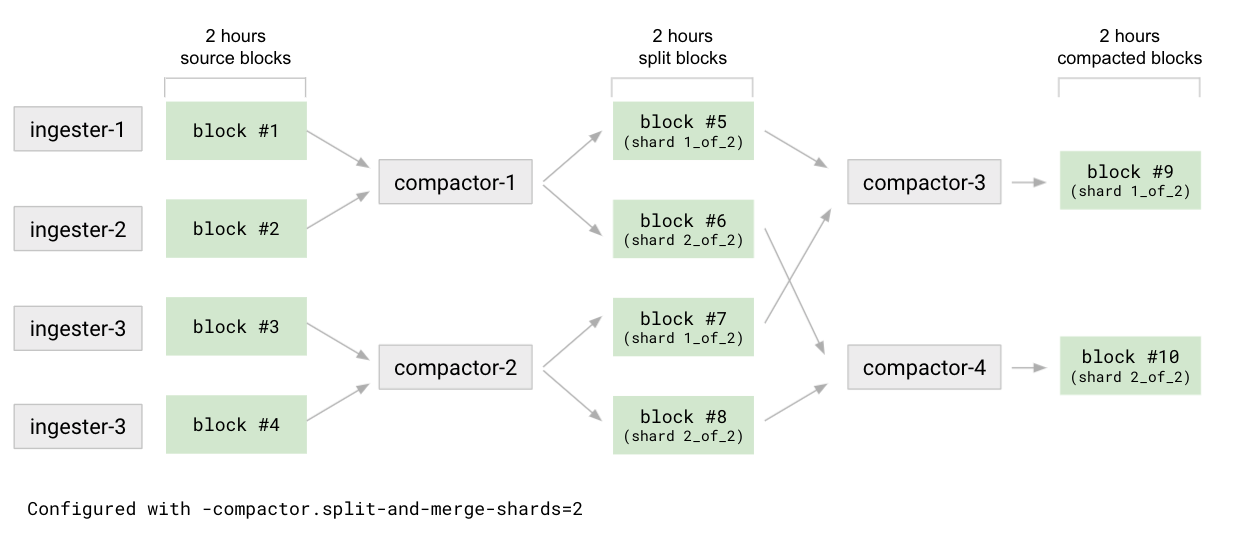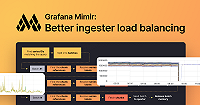Important: This documentation is about an older version. It's relevant only to the release noted, many of the features and functions have been updated or replaced. Please view the current version.
Grafana Enterprise Metrics configuration
Grafana Enterprise Metrics utilizes a configuration file that is a superset of the Grafana Mimir configuration file.
The following extensions are available in the Grafana Enterprise Metrics configuration:
Authentication
You can enable the built-in, token based authentication mechanism in Grafana Enterprise Metrics by adding the following code to your configuration file:
auth:
type: enterpriseAdmin backend storage
You need to configure Grafana Enterprise Metrics with a bucket that stores administration objects such as clusters, access policies, tokens, or licenses. Ideally, this bucket is separate from the bucket that stores the TSDB blocks.
If you do not configure the object-storage bucket or do so incorrectly, Grafana Enterprise Metrics is unable to find its license and warnings will be logged. Failure to find a license is not a fatal error to minimise operational disruption in the case of misconfiguration or license expiry.
The client that is used is configured using the same configuration options as configuring a blocks storage backend. All of the clients supported for blocks storage are also supported for the admin API.
To verify that you have configured the object-storage bucket correctly, see either the S3 / Minio backend if you are using an S3 compatible API, or Google Cloud Storage (GCS) backend if you are using Google Cloud Storage.
Below are snippets that can be included in your configuration to set up each of the common object storage backends:
S3 / Minio backend
admin_client:
storage:
type: s3
s3:
# The S3 bucket endpoint. It could be an AWS S3 endpoint listed at
# https://docs.aws.amazon.com/general/latest/gr/s3.html or the address of an
# S3-compatible service in hostname:port format.
[endpoint: <string> | default = ""]
# S3 bucket name
[bucket_name: <string> | default = ""]
# S3 secret access key
[secret_access_key: <string> | default = ""]
# S3 access key ID
[access_key_id: <string> | default = ""]
# If enabled, use http:// for the S3 endpoint instead of https://. This could
# be useful in local dev/test environments while using an S3-compatible
# backend storage, like Minio.
[insecure: <boolean> | default = false]Google Cloud Storage (GCS) backend
admin_client:
storage:
type: gcs
gcs:
# GCS bucket name
[bucket_name: <string> | default = ""]
# JSON representing either a Google Developers Console client_credentials.json
# file or a Google Developers service account key file. If empty, fallback to
# Google default logic.
[service_account: <string> | default = ""]Blocks storage
Grafana Enterprise Metrics extends Grafana Mimir’s blocks storage configuration by those features:
Rate limiting of list calls
List calls to a storage bucket can be rate limited. The blocks-storage.bucket-rate-limit.limit configuration option specifies how often per second a list call can be made before being rate limited. The blocks-storage.bucket-rate-limit.burst configuration option specifies the burst size. If blocks-storage.bucket-rate-limit.limit is smaller than or is equal to zero (the default) no rate limiting is applied. The snippet below shows how this can be set in your configuration file for an S3 backend:
blocks_storage:
backend: s3
bucket_rate_limit: 100
bucket_rate_limit_burst: 1Compactor
Grafana Enterprise Metrics uses “split-and-merge” compactor. This is a new compactor that allows the user to vertically and horizontally parallelize compaction for a single tenant. This is useful for metrics clusters with very large tenants.
split-and-merge compaction also allows GEM to overcome TSDB index limitations and prevent compacted blocks from growing indefinitely for a very large tenant (at any compaction stage).
split-and-merge compaction is a two stage process: split and merge.
For the configured 1st level of compaction (eg. 2h), the compactor divides all source blocks into N groups. For each group, the compactor compacts together the blocks, but instead of returning 1 compacted block (as with the default strategy), it outputs N blocks, called split blocks. Each split block contains a subset of the series. Series are sharded across the N split blocks using a stable hashmod function. At the end of the split stage, the compactor will have produced N * N blocks with a reference to their shard in the block’s meta.json.
Given the split blocks, the compactor runs the merge stage which compacts together all split blocks of a given shard. Once this stage is completed, the number of blocks will be reduced by a factor of N. Given a compaction time range, we’ll have a compacted block for each shard.
The merge stage is then run for subsequent compaction time ranges (eg. 12h, 24h), compacting together blocks belonging to the same shard (not shown in the picture below).

The N number of split blocks is configurable on a per-tenant basis (-compactor.split-and-merge-shards) and can be adjusted based on the number of series of each tenant. The more a tenant grows in terms of series, the more you can grow the configured number of shards, in order to improve compaction parallelization and keep each per-shard compacted block size under control. We currently recommend 1 shard per 25-30 million active series in a tenant. This means that for a tenant with 100 million active series you would set split-and-merge-shards=4. Note: This recommendation may change as this feature is still experimental.
Vertical scaling with split-and-merge compaction
To get vertical scaling use the -compactor.compaction-concurrency flag. The compaction-concurrency flag is the max number of concurrent compactions allowed to run in a single compactor replica (each compaction uses 1 CPU core).
Horizontal scaling with split-and-merge compaction
To get horizontal scaling sharding must be enabled for the compactor (sharding_enabled=true). Compaction jobs (both split and merge) will then be spread across compactor-tenant-shard-size number of compactor replicas. If compactor-tenant-shard-size is set to 0, jobs will be spread out over all compactor replicas.
Vertical and horizontal scaling both accomplish the same thing - allowing you to speed up compaction by parallelizing it either across multiple compactor replicas (horizontal scaling) or across multiple CPUs on the same compactor replica (vertical scaling). The operator can choose to use neither, one, or both types of scaling.
Below is a sample configuration for enabling split-and-merge compaction in the compactor:
compactor:
# Enable vertical scaling during the split-and-merge compaction.
# A single compactor replica can execute up to compaction_concurrency non-conflicting
# compaction jobs for a single tenant at once (in this example, 4 jobs at once).
compaction_concurrency: 4
# Enable horizontal scaling during split-and-merge compaction.
# Compaction jobs will be sharded across all available compactor replicas.
sharding_enabled: true
limits:
# Number of shards per tenant
compactor_split_and_merge_shards: 2
# Number of compactor replicas that a tenant's compaction jobs can be shared across
compactor_tenant_shard_size: 2How does the compaction behave if -compactor.split-and-merge-shards changes?
In case you change the -compactor.split-and-merge-shards setting, the change will affect only compaction of blocks which haven’t been split yet. Blocks which have already run through the split stage will not be split again to produce a number of shards equal to the new setting, but will be merged keeping the old configuration (this information is stored in the meta.json of each split block).
Ruler
The Ruler is an optional service that executes PromQL queries in order to record rules and alerts. The ruler requires backend storage for the recording rules and alerts for each tenant.
Grafana Enterprise Metrics extends Grafana Mimir’s upstream ruler configuration by those features:
Remote-write forwarding
The following configuration options can be used to enable remote write rule groups and specify a desired directory to store the generated write-ahead log (WAL). To learn more see the remote-write rule forwarding documentation
ruler:
remote_write:
enabled: <bool. defaults to false>
wal_dir: <directory path. defaults to ./wal>Remote rule evaluation using query-frontend
To authorize communication when configuring the ruler to use query-frontend for remote rule evaluation, an authorization token must be specified by setting -ruler.query-frontend.auth-token option.
During remote evaluation the ruler sets the tenant when making a request to the query-frontend based on which tenant the rulegroup is meant to query against. This means that the authorization token must be associated to an access policy that has metrics:read access to all tenants, since a rulegroup could potentially be associated with any tenant in the cluster.
An access policy that fits these requirements must have scope metrics:read and realm->tenant set to the wildcard character (*). For more information on how to do this, please see Create access policy.
Gateway
For information about the gateway and its configuration, refer to Gateway.



